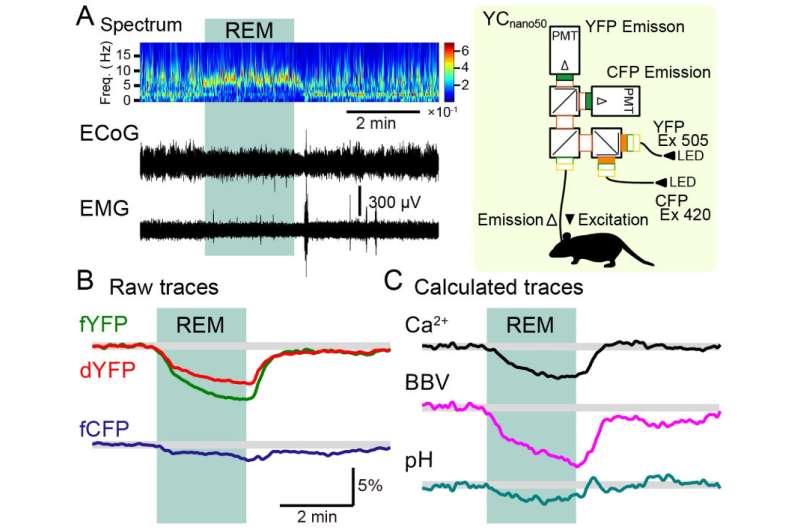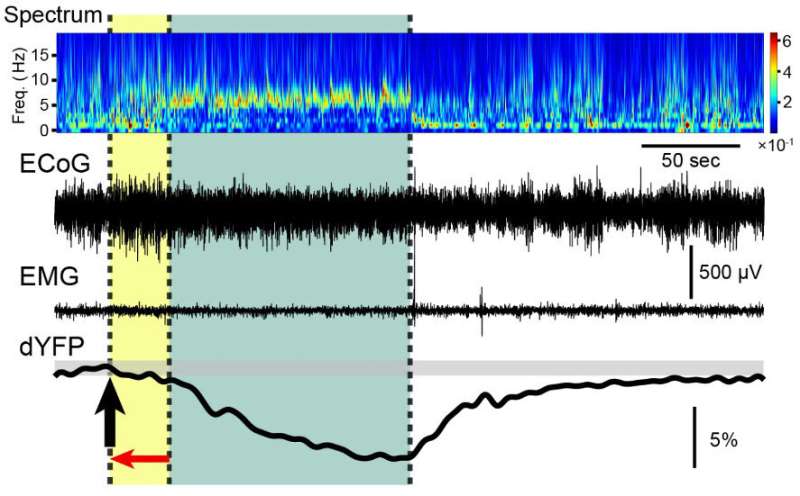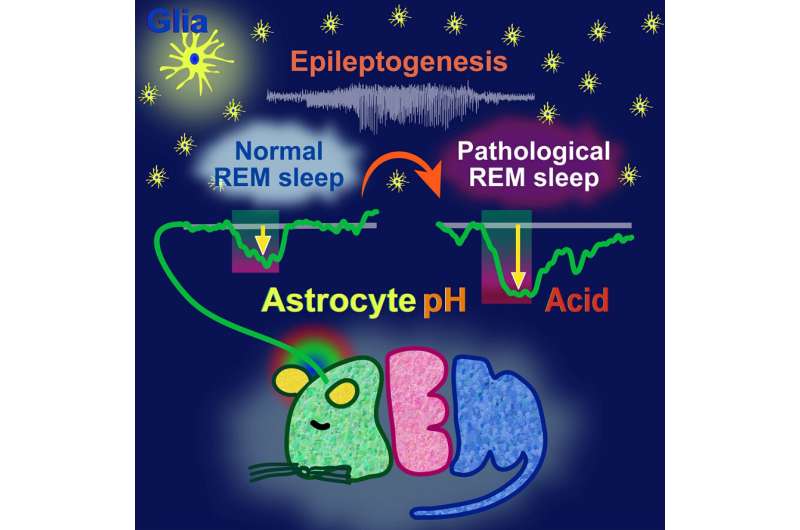This article has been reviewed according to Science X's editorial process and policies. Editors have highlighted the following attributes while ensuring the content's credibility:
fact-checked
peer-reviewed publication
trusted source
proofread
Acid glia in REM sleep: Stronger acid response in epileptic mice

Researchers at Tohoku University have shown that astrocytes—star-shaped glial cells that control the local ionic and metabotropic environment of the brain—exhibit an acid response with REM sleep in mice. They theorize that the acid response could be the underlying drive for specific information processing and generating plasticity during sleep.
They further discovered that the REM response in astrocytes intensified in the epileptic brain, meaning studying brain environmental changes associated with REM sleep could potentially be employed as a biomarker for the severity of epileptogenesis.
The findings were detailed in Brain.
Neurons are undoubtedly responsible for information processing in the brain. Astrocytes were not thought to be an essential component of the neural information circuit. However, recent findings suggest that the state of the mind, such as consciousness, sleep, memory formation, and meta-plasticity may all be controlled by astrocytes' actions.
To understand the role of astrocytes in brain function, fluorescent sensor proteins were genetically expressed in the astrocytes of mice. The researchers implanted an optical fiber into the mice's lateral hypothalamus, a part of the brain vital for controlling our state of being asleep or awake and whole-body metabolism.
Excitation light was sent through this fiber and the emitted fluorescence signals were recorded. Using a newly devised method, the researchers dissected the calcium concentration and pH of the astrocytes and the local brain blood volume changes from the recorded optical signals.

A clear change in the optical signals associated with REM sleep was observed. A calcium decrease, pH decrease (i.e., acidification), and increase in local brain blood volume occurred. The researchers identified that acidification and blood volume changes produce a strong effect on the optical signals; thus, many of the previous studies using fiber photometry could have misinterpreted their recorded data.
Acidification was especially unexpected, as the intracellular solution of cells is highly buffered for pH. Strong acidification occurs upon ischemia but changes in pH were not assumed to occur under physiological conditions. This astrocyte acidification may drive the amplification of synaptic signals and may underlie memory formation during REM sleep.
Interestingly, changes in the local brain environment detected with the optical recordings preceded the signature change of the ensemble neuronal electrical activity detected with electroencephalogram by nearly 20 seconds. This suggests that astrocytes and vascular changes control the state of neuronal activity. Transition to REM sleep can also be predicted from these local brain environmental changes.
"During REM sleep, prior experiences are sorted and remembered or forgotten, and this process is likely perceived as dreams," says Professor Ko Matsui of the Super-network Brain Physiology lab at Tohoku University, who led the research. "Acidification in astrocytes may control the likelihood of plasticity to occur in the neural circuits."

The researchers further studied how the properties of REM sleep change with epilepsy. Repeated stimulus to a mouse's hippocampus produces a brain prone to hyperactivity and this "kindling" method has been used as a model of epileptogenesis. After kindling, spontaneously occurring REM sleep episodes were recorded. Surprisingly, very little astrocytic calcium decreases and local brain blood volume increases occurred with REM sleep, and a strong acid response was recorded from astrocytes.
"Our previous study has shown an increased acid response of astrocytes associated with intensified epileptic seizures," says the lead study investigator, Dr. Yoko Ikoma. "Information is transmitted and processed with electrical signals in neurons. The pH of astrocytes may have control over these neuronal activities both in physiology and in disease."
Monitoring of the bulk pH and local brain blood flow is possible in humans using fMRI. Ikoma says that these local brain environmental changes associated with REM sleep can potentially be used to diagnose the severity of epilepsy in human patients. "A therapeutic strategy designed to control astrocytes' pH could potentially be used for preventing exacerbation of epilepsy."
More information: Yoko Ikoma et al, Properties of REM sleep alterations with epilepsy, Brain (2023). DOI: 10.1093/brain/awac499




















